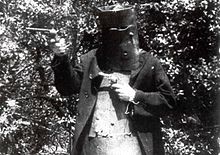Feature film
A feature film is a film with a running time long enough to be considered the principal or sole film to fill a program. The notion of how long this should be has varied according to time and place. According to the Academy of Motion Picture Arts and Sciences, American Film Institute, and British Film Institute, a feature film runs for 40 minutes or longer, while the Screen Actors Guild states that it is 80 minutes or longer.
The majority of feature films are between 70 and 210 minutes long. The Story of the Kelly Gang was the first feature film based on length, and was released in Australia in 1906. The first feature-length adaptation was Les Misérables which was released in 1909.
Feature films for children are usually between 70 and 105 minutes. Other early feature films include a version of Oliver Twist (1912), Richard III (1912) and From the Manger to the Cross (1912).
Description
The Academy of Motion Picture Arts and Sciences,[1] the American Film Institute,[2] and the British Film Institute[3] all define a feature as a film with a running time of 40 minutes or longer. The Centre National de la Cinématographie in France defines it as a 35 mm film longer than 1,600 metres, which is exactly 58 minutes and 29 seconds for sound films, and the Screen Actors Guild gives a minimum running time of at least 80 minutes.[4][5] Today, feature films average about two hours in length[6]; with children's films typically shorter.
History

The term feature film came into use to refer to the main film to be presented in a cinema, and the one which was promoted or advertised. The term was used to distinguish the main film from the short films (referred to as shorts) typically presented before the main film, such as newsreels, serials, animated cartoons and live-action comedies and documentaries. These types of short films would precede the featured presentation - the film given the most prominent billing and running multiple reels. There was no sudden jump in the running times of films to the present-day definitions of feature-length; the "featured" film on a film program in the early 1910s gradually expanded from two to three to four reels.
Early proto-features had been produced in America and France, but were released in individual scenes, leaving the exhibitor the option of running them together. The American company S. Lubin released a Passion Play in January 1903 in 31 parts, totaling about 60 minutes.[7] The French company Pathé Frères released a different Passion Play, La Vie et la passion de Jésus Christ, in May 1903 in 32 parts running about 44 minutes. There were also full-length records of boxing matches, such as The Corbett-Fitzsimmons Fight (1897) [8]
Defined by length, the first dramatic feature film was the Australian 70-minute film The Story of the Kelly Gang (1906).[9] Similarly, the first European feature was the 90-minute film L'Enfant prodigue (France, 1907), although that was an unmodified record of a stage play; Europe's first feature adapted directly for the screen, Les Misérables, came from France in 1909.[9] The first Russian feature was Defence of Sevastopol in 1911.[10] The first UK features were the documentary With Our King and Queen Through India (1912), filmed in Kinemacolor[11] and Oliver Twist (1912).[9] The first American features were a different production of Oliver Twist (1912), From the Manger to the Cross (1912), and Richard III (1912), the latter starring actor Frederick Warde.[12] The first Asian feature was Japan's The Life Story of Tasuke Shiobara (1912),[13] the first Indian feature was Raja Harishchandra (1913),[14] the first South American feature was Brazil's O Crime dos Banhados (1913),[13] and the first African feature was South Africa's Die Voortrekkers (1916).[13] 1913 also saw China's first feature film, Zhang Shichuan's Nan Fu Nan Qi.
By 1915 over 600 features were produced annually in the United States.[15] The most prolific year of U.S. feature production was 1921, with 682 releases; the lowest number of releases was in 1963, with 213.[15] Between 1922 and 1970, the U.S. and Japan alternated as leaders in the quantity of feature film production. Since 1971, the country with the highest feature output has been India,[16] which produces a thousand films in more than twelve Indian languages each year.[17]
References
- ^ http://www.oscars.org/79academyawards/rules/rule02.html
- ^ The American Film Institute Catalog of Motion Pictures
- ^ Denis Gifford, The British Film Catalogue
- ^ http://www.sagaftra.org/files/sag/Low_Budget_Ageement_1_5.pdf
- ^ http://www.sagindie.org/docs/sag-modifiedlowbudget-2005wm.pdf
- ^ By The Numbers: The Length Of Feature Films
- ^ Passion Play" (1903), in: The American Film Institute Catalog of Motion Pictures [online database].
- ^ Charles Musser, The Emergence of Cinema: The American Screen to 1907, p. 197�??200.
- ^ a b c Patrick Robertson, Film Facts, New York: Billboard Books, 2001, p. 9. ISBN 0-8230-7943-0.
- ^ Patrick Robertson, Film Facts, New York: Billboard Books, 2001, p. 13. ISBN 0-8230-7943-0.
- ^ Charles Urban, A Yank in Britain: The Lost Memoirs of Charles Urban, Film Pioneer, The Projection Box, 1999, p. 79. ISBN 978-0-9523941-2-9.
- ^ Patrick Robertson, Film Facts, New York: Billboard Books, 2001, p. 10. ISBN 0-8230-7943-0.
- ^ a b c Patrick Robertson, Film Facts, New York: Billboard Books, 2001, p. 10�??14. ISBN 0-8230-7943-0.
- ^ Patrick Robertson, Film Facts, New York: Billboard Books, 2001, p. 12. ISBN 0-8230-7943-0.
- ^ a b American Film Institute Catalog of Motion Pictures [online database].
- ^ Patrick Robertson, Film Facts, New York: Billboard Books, 2001, p. 15.
- ^ Nelmes, Jill (2003), "10", An introduction to film studies (3 ed.), Routledge, p. 360, ISBN 0-415-26268-2
